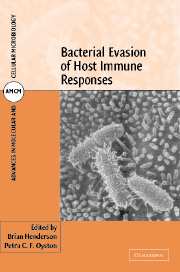Book contents
- Frontmatter
- Contents
- Contributors
- Preface
- Part I Recognition of bacteria
- Part II Evasion of humoral immunity
- Part III Evasion of cellular immunity
- 7 Type III secretion and resistance to phagocytosis
- 8 Bacterial superantigens and immune evasion
- 9 Bacterial quorum sensing signalling molecules as immune modulators
- 10 Microbial modulation of cytokine networks
- 11 Enterotoxins: Adjuvants and immune inhibitors
- 12 Type III protein secretion and inhibition of NF-κB
- Index
- Plate section
- References
7 - Type III secretion and resistance to phagocytosis
from Part III - Evasion of cellular immunity
Published online by Cambridge University Press: 13 August 2009
- Frontmatter
- Contents
- Contributors
- Preface
- Part I Recognition of bacteria
- Part II Evasion of humoral immunity
- Part III Evasion of cellular immunity
- 7 Type III secretion and resistance to phagocytosis
- 8 Bacterial superantigens and immune evasion
- 9 Bacterial quorum sensing signalling molecules as immune modulators
- 10 Microbial modulation of cytokine networks
- 11 Enterotoxins: Adjuvants and immune inhibitors
- 12 Type III protein secretion and inhibition of NF-κB
- Index
- Plate section
- References
Summary
INTRODUCTION
Phagocytosis is an essential first line of defence, which normally efficiently clears and destroys microorganisms. This process is mostly attributed to professional phagocytes: macrophages, monocytes, and neutrophils, which express specialised receptors that promote phagocytosis (Rabinovitch, 1995; Aderem and Underhill, 1999; see Chapter 1). These receptors recognise opsonins such as IgG and products of complement that bind to bacterial surfaces (see Chapter 4). Following phagocytic uptake, bacteria are normally killed and destroyed inside phagosomes, especially after maturation to phagolysosomes. Maturation is caused by fusion of the phagosome with endocytic vesicles causing an increasingly acidic environment, and finally fusion with lysosomes that contain digestive enzymes, mainly acid hydrolases (Tjelle et al., 2000). The professional phagocytes can also produce reactive oxygen and nitrogen (in macrophages) intermediates that contribute to killing (Hampton et al., 1998; Vazquez-Torres et al., 2000a). When activated, these cells secrete pro-inflammatory cytokines, which in turn stimulate other immune cells. Macrophages also serve as antigen presenting cells enabling generation of specific cellular and humoral defences (Morrisette et al., 1999; see Chapter 2). Therefore, it is not surprising that many microorganisms have developed strategies to circumvent phagocyte activity. The pathogens discussed in this chapter, Yersinia and Pseudomonas aeruginosa, directly block the engulfment process and remain extracellular, while other pathogens invade phagocytes and remodel the vesicle fusion events to promote persistence and replication.
- Type
- Chapter
- Information
- Bacterial Evasion of Host Immune Responses , pp. 127 - 170Publisher: Cambridge University PressPrint publication year: 2003

